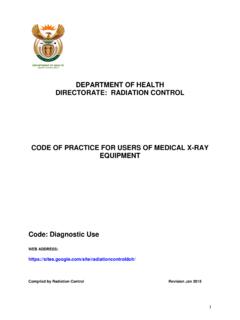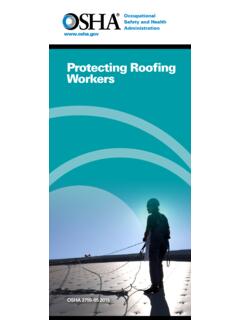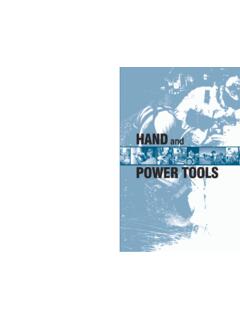Transcription of Guidance on the safe use of magnetic lifting devices
1 Guidance on the safe use of magnetic lifting devices Introduction 1 This document provides advice about reducing the risk of both injury to operators and other people, and of damage to plant and equipment from the use of magnetic lifting devices . The Guidance was previously contained in HSE Operational Circular 234/16 and the associated Information Document (aimed at users of this equipment ). It describes the hazards involved and some of the precautions that need to be considered when planning and carrying out handling activities using magnetic lifting devices . 2 The main concerns relate to electrically powered magnets used for lifting operations, but some of the issues will be equally applicable to permanent magnets. 3 This Guidance has been prepared in consultation with the Steel Stockholding Lead Authority Partnership (a tri-partite body comprising Wolverhampton City Council, the National Association of Steel Service Centres (NASS) and the Health and Safety Executive), UK Steel, the British Recycled Metals Association and the lifting equipment Engineers Association.
2 The equipment 4 Electrically operated magnetic lifting devices , in the form of a single magnet or a group of magnets suspended from chains or wires or attached to lifting equipment in another way, can be used for lifting and transporting steels and most ferrous materials or components without the need for slingers. They are widely used in many industrial sectors including metal/component manufacture and storage, shipbuilding, and metal recycling facilities. 5 Magnets can be provided without power supply permanent magnets, or where power is supplied from an external source or through an in-built battery. Electro-permanent magnets are also available where permanent magnets are utilised to hold the load and power is used to release the load. Power is used to both energise and release the load. They use a combination of permanent magnets and magnets whose polarity is switched by an electrical pulse rather than mechanically.
3 Some can be 1. partially energised to facilitate load shredding. Different shapes and types of magnet are available, for example: flat pole plate magnets for handling sheet metals and bulk goods such as scrap iron, etc;. specially-shaped pole plate magnets for lifting pipes, round steel bars or sectional steel;. magnets with adjustable pole fingers for lifting items of irregular shape;. Main hazards 6 The principal safety hazard associated with their use is from falling material. People, plant, equipment , and services in the area of operation could be at risk from being struck by material which becomes detached from the magnet due to failure of the lifting device following loss of power, or due to incorrect application or operation. 7 A potential health risk to people working in the vicinity of these magnetic lifting devices is from the electromagnetic field (EMF) around the magnet (or around the supply conductors should the currents be very large).
4 It is thought that this may interfere with the operation of implanted active body implants, such as heart pacemakers or insulin pumps (See paragraph 25). EMFs can also interfere with communication and control systems/ equipment which could be safety related and therefore, create consequent risks which should also be assessed. Legal requirements 8 Under the lifting Operations and lifting equipment Regulations 1998 (LOLER), magnetic lifting devices that are an integral part of machinery are classed as ' lifting equipment '; those that can be fitted to, and taken off, lifting equipment are considered to be 'accessories for lifting '. ' lifting equipment ' and 'accessories for lifting ' are both 'work equipment ' within the meaning of the Provision and Use of Work equipment Regulations 1998 (PUWER). 9 The key requirements under LOLER and PUWER are set out in HSE Guidance (see Further Reading). and on the HSE webpages Work equipment and machinery.
5 Additionally, the Safety Assessment Federation (SAFed) publish guidelines on what their assessment engineers look for during the thorough examination and test as required by LOLER. The relevant guide for electrically operated magnetic lifting devices (ref MLCC08) can be downloaded from SAFed's website at Machinery Lift and Crane Guidelines. 10 magnetic lifting equipment supplied (or put into service) for the first time in the EU should meet the requirements of the Machinery Directive, as implemented by the Supply of Machinery (Safety). Regulations 2008. Further information is set out in HSE Guidance at Work equipment and machinery. The current harmonised European Standard for magnetic lifting devices is BS EN 13155:2003+A2:2009. Cranes - Safety Non-fixed load lifting attachments. 11 Suppliers of second-hand work equipment have duties under Section 6 of the Health and Safety at Work etc Act and further Guidance is available on the HSE webpages Second-hand (re-supplied).
6 Products - Work equipment and machinery Precautions 2. General 12 equipment suppliers should provide suitable technical information, particularly about the strengths and distribution of magnetic fields around the magnet for typical load configurations, so that users may complete appropriate risk assessments for its use and maintenance. Where an external electrical power supply is required suppliers should provide information on power requirements. 13 Before recommending or supplying magnetic lifting equipment , suppliers should: Obtain sufficient information from the prospective user to ensure the equipment supplied will be safe for its intended use mass, shape, dimensions, structural stiffness, magnetic properties of the load;. Provide adequate information about the use for which the equipment was designed and tested;. Advise prospective users about risks of direct or indirect effects on their employees and other people present on site (eg haulage drivers).
7 Provide adequate information on any potential electromagnetic compatibility issues. 14 magnetic lifting devices should not be treated as 'general purpose' pieces of lifting gear as they have to be designed to suit particular types of loads and environments. Users should seek advice from the equipment manufacturer on the suitability of an existing device for all new applications. 15 Consider (as part of your risk assessment) installing permanent magnets with electromagnetic release so that in the event of a power failure, battery backup will not be needed. Safety measures 16 The following safety measures should be considered [where equipment which is not to the current BS EN 13155:2003+A2:2009] and provided where reasonably practicable - Warning devices - equipment for lifting should be fitted with suitable warning devices and indicators to show when it is magnetised or operating at a reduced power level Protection against failure of electrical supply - Except for the permanent or electro-permanent magnet types, any interruption to the electrical supply could result in a release of the load.
8 Consequently for battery-fed devices with a safe working load (SWL) of greater than 20 kg o An automatic warning should be provided which monitors the power supply and provides a warning at least 10 minutes before the supply reaches the level where the load will be released. The warning device should be optical or acoustic. o After the automatic warning device has been activated and the magnet has been switched off, the magnet should be prevented from being switched on again until the battery is recharged to a greater level at which the automatic warning device is activated. For external electrical supply devices with a SWL of greater than 20 kg o An automatic warning device should be provided to warn if the external power supply fails. The warning may be optical or acoustic. o A stand-by battery should be provided to automatically supply power when the external supply fails. It should be capable of providing the current needed to hold the SWL for at least 10.
9 Minutes. 3. o Where magnets are to be used in areas in close proximity to persons, redundancy should be provided by duplication of power cables, connections and power controller. Alternatively a secondary positive holding device should be provided. Protection against inadvertent operation of the controls - Releasing the load should require two control actions. Risk assessment 17 Employers should carry out a suitable and sufficient assessment of the risks, before new or existing magnetic lifting devices are specified for handling loads. This should consider whether such devices are appropriate and suitable taking into account all the circumstances of the proposed operation. Additionally, the proximity of persons to magnet should be considered (for all risks) and whether it is foreseeable that persons may deliberately or inadvertently approach the magnet. The assessment should be carried out by someone with knowledge of the material storage and handling processes, as well as the capabilities and limitations of this type of lifting equipment .
10 Employees and their safety representatives with first-hand knowledge of the hazards and risks involved should be consulted during risk assessment. 18 Some of the factors that have a bearing on the selection of lifting magnets and operating conditions, particularly the SWL, include: magnetic properties of the load - Magnet lifting is not appropriate for all steels. For example, some stainless steels are not magnetic and other types are only partially magnetic . When handling mixed steel types, it should be recognised that non/partially magnetic items are likely to fall away if magnetised pieces supporting them move. Load weight, thickness, shape and area in contact with magnet - The surface area of the load and the proportion of the magnet face in contact with it will dictate the number and size of magnets required for safe handling almost as much as the weight and thickness of the load. For example, a billet may only require a single two-pole magnet, whereas a thin plate section of equal weight may require a multiple arrangement of magnets.














